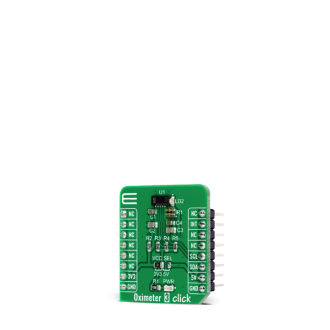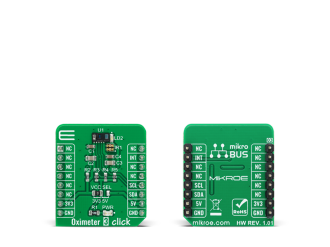
We strongly encourage users to use Package manager for sharing their code on Libstock website, because it boosts your efficiency and leaves the end user with no room for error. [more info]

Rating:
Author: MIKROE
Last Updated: 2020-09-03
Package Version: 1.0.0.0
mikroSDK Library: 1.0.0.0
Category: Biometrics
Downloaded: 2534 times
Not followed.
License: MIT license
Oximeter 3 Click is a compact add-on board perfectly suited for measuring the blood oxygen saturation. This board features the VCNL4020C-GS08, a fully integrated high-resolution digital biosensor from Vishay Semiconductors.
Do you want to subscribe in order to receive notifications regarding "Oximeter 3 click" changes.
Do you want to unsubscribe in order to stop receiving notifications regarding "Oximeter 3 click" changes.
Do you want to report abuse regarding "Oximeter 3 click".


Library Description
Library provides generic functions for reading and writig data to register and getting INT pin status. There is one specific function that reads data from sensor and returns it, which data returns depends on input parameter.
Key functions:
void oximeter3_generic_write ( uint8_t reg_addr, uint8_t write_data ) - Function for writing data to register address.uint8_t oximeter3_generic_read ( uint8_t reg_addr ) - Function for reading data from register address.uint16_t oximeter3_read_value ( uint8_t type_macro ) - Function for reading value from sensor.Examples description
The application is composed of three sections :
void application_task ( )
{
if ( OXIMETER3_HEART_RATE == dev_mode )
{
rd_val = oximeter3_read_value( OXIMETER3_PROX );
WordToStr( rd_val, demo_txt );
mikrobus_logWrite( demo_txt, _LOG_TEXT );
mikrobus_logWrite( ",", _LOG_LINE );
Delay_ms( 3 );
}
else
{
rd_val = oximeter3_read_value( OXIMETER3_PROX );
WordToStr( rd_val, demo_txt );
mikrobus_logWrite( " * Proximity: ", _LOG_TEXT );
mikrobus_logWrite( demo_txt, _LOG_LINE );
rd_val = oximeter3_read_value( OXIMETER3_ALS );
WordToStr( rd_val, demo_txt );
mikrobus_logWrite( " * ALS: ", _LOG_TEXT );
mikrobus_logWrite( demo_txt, _LOG_LINE );
mikrobus_logWrite( "********************", _LOG_LINE );
Delay_ms( 500 );
}
}
Other mikroE Libraries used in the example:
Additional notes and informations
Depending on the development board you are using, you may need USB UART click, USB UART 2 click or RS232 click to connect to your PC, for development systems with no UART to USB interface available on the board. The terminal available in all MikroElektronika compilers, or any other terminal application of your choice, can be used to read the message.